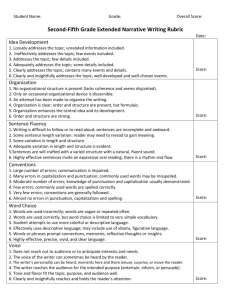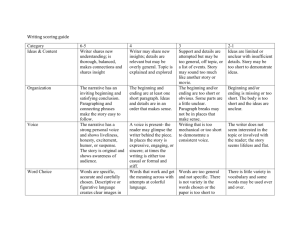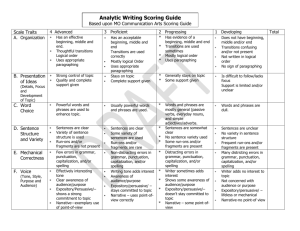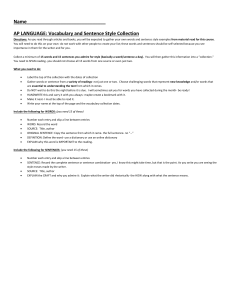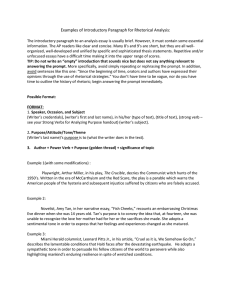Breadwinner Informative Essay Rubric
advertisement
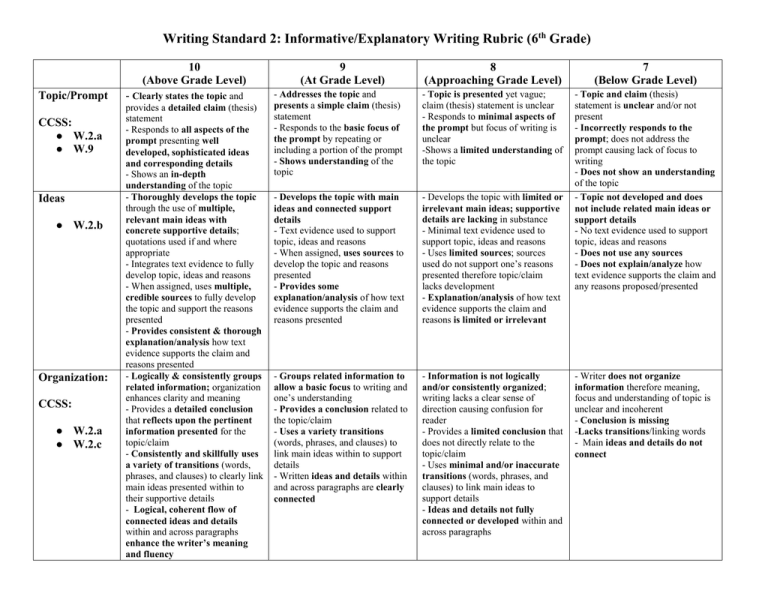
Writing Standard 2: Informative/Explanatory Writing Rubric (6th Grade) 10 (Above Grade Level) Topic/Prompt CCSS: ● W.2.a ● W.9 Ideas ● W.2.b Organization: CCSS: ● W.2.a ● W.2.c - Clearly states the topic and provides a detailed claim (thesis) statement - Responds to all aspects of the prompt presenting well developed, sophisticated ideas and corresponding details - Shows an in-depth understanding of the topic - Thoroughly develops the topic through the use of multiple, relevant main ideas with concrete supportive details; quotations used if and where appropriate - Integrates text evidence to fully develop topic, ideas and reasons - When assigned, uses multiple, credible sources to fully develop the topic and support the reasons presented - Provides consistent & thorough explanation/analysis how text evidence supports the claim and reasons presented - Logically & consistently groups related information; organization enhances clarity and meaning - Provides a detailed conclusion that reflects upon the pertinent information presented for the topic/claim - Consistently and skillfully uses a variety of transitions (words, phrases, and clauses) to clearly link main ideas presented within to their supportive details - Logical, coherent flow of connected ideas and details within and across paragraphs enhance the writer’s meaning and fluency 9 (At Grade Level) 8 (Approaching Grade Level) 7 (Below Grade Level) - Addresses the topic and presents a simple claim (thesis) statement - Responds to the basic focus of the prompt by repeating or including a portion of the prompt - Shows understanding of the topic - Topic is presented yet vague; claim (thesis) statement is unclear - Responds to minimal aspects of the prompt but focus of writing is unclear -Shows a limited understanding of the topic - Develops the topic with main ideas and connected support details - Text evidence used to support topic, ideas and reasons - When assigned, uses sources to develop the topic and reasons presented - Provides some explanation/analysis of how text evidence supports the claim and reasons presented - Develops the topic with limited or irrelevant main ideas; supportive details are lacking in substance - Minimal text evidence used to support topic, ideas and reasons - Uses limited sources; sources used do not support one’s reasons presented therefore topic/claim lacks development - Explanation/analysis of how text evidence supports the claim and reasons is limited or irrelevant - Topic and claim (thesis) statement is unclear and/or not present - Incorrectly responds to the prompt; does not address the prompt causing lack of focus to writing - Does not show an understanding of the topic - Topic not developed and does not include related main ideas or support details - No text evidence used to support topic, ideas and reasons - Does not use any sources - Does not explain/analyze how text evidence supports the claim and any reasons proposed/presented - Groups related information to allow a basic focus to writing and one’s understanding - Provides a conclusion related to the topic/claim - Uses a variety transitions (words, phrases, and clauses) to link main ideas within to support details - Written ideas and details within and across paragraphs are clearly connected - Information is not logically and/or consistently organized; writing lacks a clear sense of direction causing confusion for reader - Provides a limited conclusion that does not directly relate to the topic/claim - Uses minimal and/or inaccurate transitions (words, phrases, and clauses) to link main ideas to support details - Ideas and details not fully connected or developed within and across paragraphs - Writer does not organize information therefore meaning, focus and understanding of topic is unclear and incoherent - Conclusion is missing -Lacks transitions/linking words - Main ideas and details do not connect Language *Word Choice/Voice CCSS: ● L.6 Language *Sentence Fluency CCSS: ● L.3 ● W.1.d ● W.4 Language *Conventions ● L.1 ● L.2 10 (Above Grade Level) 9 (At Grade Level) 8 (Approaching Grade Level) 7 (Below Grade Level) - Consistently uses precise, topicspecific vocabulary to inform about or explain the topic. - Word choice is powerful, factual and accurate providing reader with a strong visual understanding - Consistently uses formal writing style to appeal to specific, targeted audience - Consistently uses varied sentence structure (varied starts and lengths) to best enhance meaning - Consistently uses well structured, complete sentences - Avoids run-ons and/or fragments - Writer skillfully constructs sentences that provide fluidity to overall piece - Consistently uses accurate grammar, punctuation, capitalization, and spelling - Correct use of conventions enhance meaning - Proper citing of evidence and assigned format followed throughout written piece - Uses topic-specific vocabulary to inform about or explain the topic. - Word choice is clear and concise - Uses appropriate writing style to appeal to a general audience - Uses limited topic-specific vocabulary - Writer struggles to find words to convey information - Inconsistently uses formal writing style; audience is unclear - Does not use topic specific vocabulary - Writer unable to express oneself and thus unable to explain stated topic or reasoning - Does not use formal writing style - Uses some varied sentence structure though varied starts are lacking - Sentences are adequately constructed and mostly uses complete sentences - Minimal run-ons and fragments - Some choppiness occurs throughout written structure - Uses basic, simple sentence structure which lacks in variety and interest - Inconsistently uses complete sentences - Frequent run-ons and fragments - Writing is choppy so overall meaning is obscured - Uses incorrect sentence structure with no variation in style - Sentences are poorly constructed; majority of sentences are run-ons and fragments - Writing is choppy and difficult to follow - Limited errors in grammar, punctuation, capitalization, and spelling - Simple errors do not interfere with reader’s understanding - Writer shows some difficulty with citing evidence and following assigned format - Multiple errors in grammar, punctuation, capitalization, and spelling - Frequent errors obscure meaning - Writer does not cite evidence accurately or consistently - Demonstrates limited understanding of grammar, punctuation, capitalization, and spelling conventions - Errors interfere with meaning and causes confusion for reader - Writer does not cite evidence correctly Student Name _____________________________ Total Score _______________________ / 60 points

